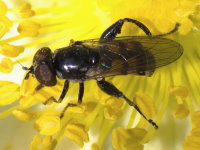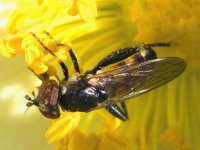Phylum Arthropoda (Arthropods) ➔ Subphylum Hexapoda (Hexapods) ➔ Class Insecta (Insects) ➔ Order Diptera (True flies) ➔ Family Syrphidae (Hoverflies)
Tropidia scita (Harris, 1780)
Keulen-Grashalmschwebfliege
Synonyms and other combinations:
Musca scita Harris, 1780 | Eristalis milesiformis Fallen, 1817 | Milesiformis fallenii Rondani, 1844 | Tropidia dorsalis Macquart, 1829 | Tropidia rufomaculata Curtis, 1832 |
Classification:
Tropidia scita belongs to the subfamily Eristalinae.Distribution:
From Fennoscandia south to central France; from Ireland eastwards through central Europe and on through Russia to the Caucasus and in Asia as far as the Pacific coast and Japan.Habitat:
Moist to wet nutrient-rich biotopes with open waters, almost always near reeds; frequently in swamp forests, at slow flowing waters, in humid, unimproved grassland, also in coastal regions in association with freshwater marsh.Description:
Body length 7 - 11 mm; wing length 5.5 - 8.25 mm; arista (antennal bristle) glabrous; face with clearly protruding mouth edge; abdomen yellow-black; hind femora thickened with large triangular projection on the underside, shortly before apex.Female: Hind femora entirely black or black except for a narrowly light apex.
The hind femora of the females of the second European Tropidia species Tropidia fasciata are yellow at the base.
Biology:
Adults of Tropidia scita are found from May to August, with occasional specimens on into September. Little is known about the life of the species. The species probably forms two generations, whereby the smaller 2nd generation probably develops only under favorable conditions.The adult flies are flower visitors. They were observed on ranunculaceae (Potentilla erecta, Ranunculus), umbelliferae, Cardamine, Corydalis, Euphorbia, Galium, Iris pseudacorus, Myosotis, Rubus, Sorbus aucuparia, Symphytum, Vaccinium and Valeriana.
The larvae probably live and develop in the decaying vegetation at the margins of ponds, ditches and other water bodies. A larva of Tropidia scita was found between the basal leaf sheaths of common bulrush (Typha latifolia). The larvae probably pupate in the litter layer in the reed vegetation.
References, further reading, links:
- Pape T. & Thompson F.C. (eds) (2017). Systema Dipterorum (version 2.0, Jan 2011). In: Species 2000 & ITIS Catalogue of Life, 2017 Annual Checklist (Roskov Y., Abucay L., Orrell T., Nicolson D., Bailly N., Kirk P.M., Bourgoin T., DeWalt R.E., Decock W., De Wever A., Nieukerken E. van, Zarucchi J., Penev L., eds.). Digital resource at www.catalogueoflife.org/annual-checklist/2017. Species 2000: Naturalis, Leiden, the Netherlands. ISSN 2405-884X.
- Gerald Bothe: Bestimmungsschlüssel für die Schwebfliegen (Diptera, Syrphidae) Deutschlands und der Niederlande, DJN, 1984, ISBN 3-923376-07-3
- M.C.D.Speight: Species Accounts of European Syrphidae (Diptera), Glasgow 2011, Syrph the Net, the database of European Syrphidae, vol. 65, 285 pp., Syrph the Net publications, Dublin.
- Menno Reemer, Willem Renema, Wouter van Steenis, Theo Zeegers, Aat Barendregt, John T. Smit, Mark P. van Veen, Jeroen van Steenis, Laurens van der Leij: De Nederlandse Zweefvliegen (Diptera: Syrphidae), Nederlandse Fauna 8, 2009.
- Speight, M.C.D. & Sarthou, J.-P. (2014) StN keys for the identification of the European species of various genera of Syrphidae (Diptera) 2014 / Clés StN pour la détermination des espèces Européennes de plusieurs genres des Syrphidae (Diptères) 2014. Syrph the Net, the database of European Syrphidae, Vol. 80, 125 pp, Syrph the Net publications, Dublin
- Graham E. Rotheray: Colour Guide to Hoverfly Larvae (Diptera, Syrphidae) in Britain and Europe, Dipterists Digest No.9, 1993, Derek Whiteley, Sheffield, England, ISSN 0853 7260
- Anasimyia interpuncta
- Anasimyia transfuga
- Baccha elongata
- Blera fallax
- Brachyopa sp.
- Brachypalpoides lentus
- Brachypalpus laphriformis
- Brachypalpus sp.
- Brachypalpus valgus
- Ceriana conopsoides
- Ceriana vespiformis
- Chalcosyrphus femoratus
- Chalcosyrphus nemorum
- Chalcosyrphus valgus
- Cheilosia albipila
- Cheilosia albitarsis
- Cheilosia chrysocoma
- Cheilosia illustrata
- Cheilosia pagana
- Cheilosia scutellata
- Cheilosia sp.
- Cheilosia variabilis
- Chrysogaster sp.
- Chrysotoxum bicinctum
- Chrysotoxum fasciatum
- Chrysotoxum festivum
- Chrysotoxum verralli
- Criorhina berberina
- Dasysyrphus albostriatus
- Dasysyrphus sp.
- Dasysyrphus tricinctus
- Didea fasciata
- Didea intermedia
- Didea sp.
- Epistrophe diaphana
- Epistrophe eligans
- Epistrophe flava
- Epistrophe grossulariae
- Epistrophe melanostoma
- Epistrophe melanostoma/nitidicollis
- Epistrophella euchroma
- Episyrphus balteatus
- Eristalinus aeneus
- Eristalinus megacephalus
- Eristalinus taeniops
- Eristalis arbustorum
- Eristalis interrupta
- Eristalis intricaria
- Eristalis lineata
- Eristalis pertinax
- Eristalis rupium
- Eristalis similis
- Eristalis sp.
- Eristalis tenax
- Eumerus purpurariae
- Eumerus sp.
- Eupeodes corollae
- Eupeodes luniger
- Eupeodes sp.
- Eurimyia lineata
- Ferdinandea cuprea
- Hammerschmidtia ferruginea
- Helophilus hybridus
- Helophilus pendulus
- Helophilus sp.
- Helophilus trivittatus
- Ischiodon aegyptius
- Leucozona glaucia
- Leucozona laternaria
- Leucozona lucorum
- Melangyna lasiophthalma
- Melangyna quadrimaculata
- Melangyna umbellatarum
- Melanogaster sp.
- Melanostoma scalare
- Meligramma triangulifera
- Meliscaeva cinctella
- Merodon ambiguus
- Merodon avidus
- Merodon equestris
- Merodon moenium
- Merodon obscuritarsis
- Merodon sp.
- Microdon analis/major
- Microdon mutabilis/myrmicae
- Myathropa florea
- Myolepta dubia
- Orthonevra sp.
- Paragus sp.
- Parasyrphus lineolus
- Parhelophilus sp.
- Pipiza austriaca
- Pipiza bimaculata
- Pipiza fenestrata
- Pipiza quadrimaculata
- Pipiza sp.
- Platycheirus rosarum
- Platycheirus sp.
- Rhingia campestris
- Rhingia rostrata
- Scaeva albomaculata
- Scaeva pyrastri
- Scaeva selenitica
- Sericomyia lappona
- Sericomyia silentis
- Sphaerophoria rueppelli
- Sphaerophoria scripta
- Sphaerophoria sp.
- Sphegina sp.
- Spilomyia saltuum
- Syritta pipiens
- Syrphus ribesii
- Syrphus sp.
- Syrphus vitripennis
- Temnostoma bombylans
- Temnostoma meridionale
- Temnostoma vespiforme
- Tropidia scita
- Volucella bombylans
- Volucella inanis
- Volucella inflata
- Volucella pellucens
- Volucella zonaria
- Xanthogramma citrofasciatum
- Xanthogramma pedissequum
- Xylota segnis
- Xylota sp.
- Xylota sylvarum

